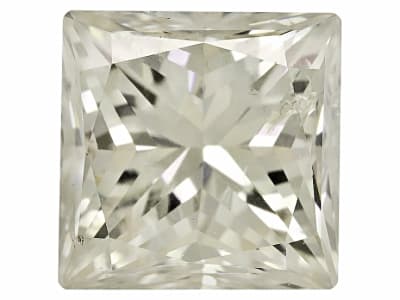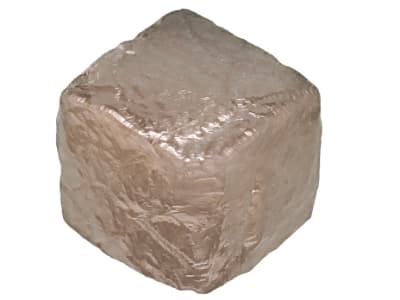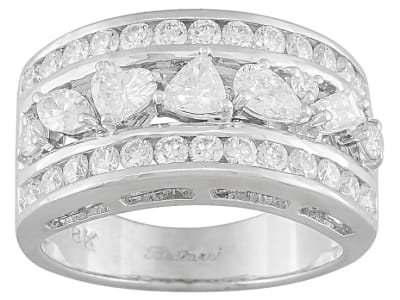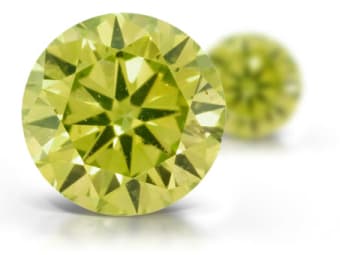Diamonds hold a special place in the gemstone worlds heart. Walk into any jewelry store and you will see display cases filled with diamond jewelry. Since the mid-20th century diamond engagement rings have become a requirement for most marriages. Diamonds are the birthstone for April and is recommended for 60th and 75th wedding anniversaries. Diamonds are the hardest known natural material. It displays the highest gemstone luster and exceptional dispersion. Both diamonds and graphite are made up of carbon but differences in the formation process produce end products with vastly different physical properties. The unique properties of diamond make it the perfect material for numerous industrial uses. The Golconda mines in India are the first recorded source of diamond mining and produced some of the most famous diamonds in history. In the 1720’s Brazil surpassed India as the major diamond producer. In the 1860’s diamonds were discovered in South Africa and this discovery has spurred the diamond market we know it today. Later discoveries in other African countries, Russia, Australia, and Canada supply the great demand for diamonds in the modern market. Diamonds were first synthesized in the 1950’s using the (HPHT) high-pressure, high temperature process. The (CVD) chemical vapor deposition process was later developed and produces many of the high-quality synthetic diamonds in today’s market.
General Information
LWUV: Colorless: commonly inert or weak to strong blue but could be any color, generally a stronger reaction than under SWUV; Occasional phosphorescence of 30 seconds or less. Red Stones: inert to medium to strong blue.Red Type II stones: inert to medium to strong orange.Blue Type IIb: Inert.Blue Type IIa: sometimes weak to strong blue, greenish blue, green, yellow or orange.Orange, yellow or brown stones: inert, faint to moderate to strong blue.Gray or black stones: Inert to strong blue is usual but can be any color.
Diamond Colors
-
 Black
Black -
 Blue
Blue -
 Brown
Brown -
 Brown
Brown -
 Brown
Brown -
 Colorless
Colorless -
 Gray
Gray -
 Green
Green -
 Orange
Orange -
 Pink
Pink -
 Purple
Purple -
 Red
Red -
 White
White -
 Yellow
Yellow
Diamond Spectra
We acknowledge the significant scientific contributions of John S Harris, FGA to the study of gemstone spectra and with deep appreciation to him, acknowledges the use of his images and related notes about gemstones and their spectra in the educational materials on this website.
Countries of Origin
Tanzania, United Republic Of; Afghanistan; Argentina; Iran (Islamic Republic of); Multiple; United States of America; Thailand; Congo; India; Canada; Unknown; China; Brazil; Italy; South Africa; Australia; Germany
History
Let's face it - diamonds are the quintessential gemstone. They're a girl's best friend... the forever stone...Sure, diamond is the only gemstone composed of a single element - carbon. Sure, it's the hardest gemstone, measuring a 10 on the hardness scale, but that's not why we love diamonds. It's their sparkle, their promise... it's the white light that dances. It's the way they say you have arrived.
Care
Normal care for natural diamonds. For treated diamonds avoid extreme heat, temperature changes, steaming, chemicals and ultrasonic cleaners. In addition to the above precautions: Avoid jeweler's torch and recutting.
More About Diamond
The ancient Greeks and Romans, who were clearly fanciful folks, thought that diamonds might be the tears of the gods, or that they were fragments of falling stars. Plato saw diamonds as living beings that embodied celestial spirits.
Creation Method
Lab Grown-HPHT
High pressure, high temperature Lab Grown diamonds (HPHT diamonds) are produced in a way similar to synthetic flux grown gems, however, during the HPHT process, as the name implies, the growth chamber is exposed to high temperature and pressure. The diamonds then crystallize in a lower temperature section of the growth chamber. Colored diamonds can be produced in this way. Lab Grown gems have the same chemical, optical, and physical properties of their natural counterparts, but are a more cost-effective alternative to a natural gem.
LWUV: Variable
Lab Grown-CVD
Chemical vapor deposition diamonds (CVD diamonds) are fairly uncommon. These Lab Grown Diamond gems crystallize from a chemical-rich vapor due to a chemical reaction that releases carbon atoms. These carbons atoms are then free to bond to a diamond seed plate where they form crystals. Lab Grown gems have the same chemical, optical, and physical properties of their natural counterparts, but are a more cost-effective alternative to a natural gem.
LWUV: Inert to weak orange to yellow-orange.
Enhancement
Laser Drilled
In light or colorless gemstones, dark inclusions are more easily seen than colorless ones, so a means of lightening dark inclusions was developed using lasers. In laser drilling treatments, a narrow channel is laser drilled from the stone's surface to the dark inclusion. Once the open channel has been created, a mixture of boiling acid is introduced under pressure and the inclusion is subsequently bleached or dissolved.
LWUV: Variable
HPHT
HPHT is an acronym for a process using High Pressure and High Temperatures. In this high-tech treatment technique, diamonds are subjected to extremely high temperatures and high pressures using similar equipment to that in which diamonds are synthesized. The heat and pressure simulate conditions during a diamond's formation deep in the Earth, and can cause alterations in the diamond's crystal structure and resulting appearance, thereby improving or altering a diamonds color.
LWUV: Variable
Irradiated
Exceptional quality colored diamonds are rare and extremely expensive. However, naturally dark or tinted diamonds can be irradiated to create a more pleasing, uniform color. Modern irradiation practices leave diamonds vibrantly colored and non-radioactive, creating beautiful options for gemstone collecting and jewelry. Once a diamond has been irradiated it becomes very sensitive to heat, so jewelers need to take care when using a jeweler's torch.
LWUV: Variable
Fracture-Filled
Fracture filling is the filling of surface-breaking cavities or fissures with highly refractive colorless glass. This process improves the apparent clarity of a diamond.
LWUV: Colorless: Variable









